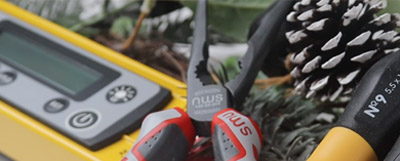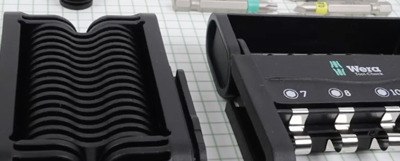Stars and Splines Forever
Posted by Chris on Jul 23rd 2024
A while back we made a video on Torx bits, sockets, etc., and we really ended up a long way down the rabbit hole. What with internal Torx, external Torx, then Torx-Plus, then the security variants on all of those, things got complicated in a hurry. Well, the use of Torx fasteners has become much more widespread, so you’re likely to see those fairly often these days. However, there are a number of other star-shaped drive styles that can also come up, and as with Torx, it’s essential to know how to identify them to save yourself the headache of stripped or broken fasteners caused by using the wrong drive type.
First off we’ll look at XZN, also known as triple-square, as this style has 12 teeth formed by superimposing three squares on top of each other, each rotated 30 degrees. This forms teeth that have a 90 degree angle. You’ll see these quite often in the automotive world, especially on bolts that require a high degree of torque, as all those teeth increase the surface area of driver to fastener, allowing a super-tight grip. And while technically you will see sizes from M4 – M18, you will almost never encounter the odd-numbered sizes in the wild (e.g. M7, M9, etc.). Be careful too, as there is another much less common 12-point drive style called double hex. This has teeth formed by superimposing two hexagons on top of each other with one slightly rotated from the other. While it also has 12 points, the angle of the points is 120 degrees, so it looks a bit “flatter”. You often will see XZN used on German cylinder heads, while double hex can show up on Toyota cylinder heads.
While we’re talking about cylinder heads, another type of drive you might encounter is a 6-point design that has flattish points – sort of like a Torx, but not quite. There are trademarked names for these drives, RIBE (from the Richard Berger Company) and Polydrive (from the Italian Company, Brugola). These are two types that not only allow high torque, but also resist cam-out. This style of drive also allows engineers to minimize the diameter of the head in relation to the drive size. And while these look remarkably similar, there are subtle differences, as the Polydrive splines are slightly thicker and have rounded junctions where the splines meet - RIBE are more squared off at the junctions.
While most of the designs we’ve talked about so far are internal drive, i.e. bits or bit sockets to tighten or loosen a fastener, spline drive is usually (though not always) an external, 12-lobed drive. Also, it might be easy to mistake a standard 12-point hex socket with a spline drive socket (or an XZN bit for a spline drive bit); however, a closer look reveals the squared-off ends of the spline drive, versus the angled, shallower ends of the hex socket. And while drives like RIBE or Polydrive are relatively recent innovations, versions of spline drive have been around for nearly 100 years. Again, the large drive size in relation to diameter of the head meant that spline drive was initially used for set screws, but later found widespread use in the aviation industry, where the high-torque capability was essential. Another advantage in this design is the tight tolerances between fastener and driver, which can minimize the possibility of small bits of worn fasteners from getting into the sensitive parts of aircraft (“FOD”).
Common to all of these styles is the ability to withstand high torque requirements, so you might see these drives on cylinder heads, brake fasteners, aerospace components of all sorts, and heavy machinery. Indeed some of the fasteners can be heat-treated, hardened steels, which require high torque values and are thus much less likely to loosen when subjected to heat extremes, heat cycling or vibrations. So, if you see star-shaped fasteners out there, take a moment to make sure you’re using the right driver for the job – with these types of drives, bits or sockets should fit snugly. If you notice a lot of play or have difficulty getting the driver to fit in the fastener, you might just have the wrong type of driver.

 Gift Ideas
Gift Ideas
 Tool of the Day™
Tool of the Day™
 Essentials
Essentials
 The Seasonal
The Seasonal
 New Arrivals
New Arrivals
 Staff Picks
Staff Picks
 Sale
Sale
 Clearance
Clearance
 Wera
Wera
 Knipex
Knipex
 Hazet
Hazet
 Stabila
Stabila
 Felo
Felo
 NWS
NWS
 Heyco
Heyco
 Bits & Accessories
Bits & Accessories
 Cutters & Pincers
Cutters & Pincers
 Pliers
Pliers
 Ratchets & Sockets
Ratchets & Sockets
 Screwdrivers
Screwdrivers
 Wrenches
Wrenches





